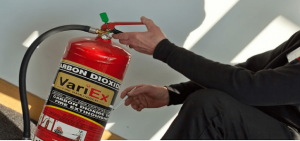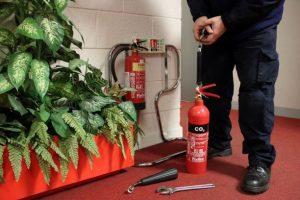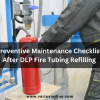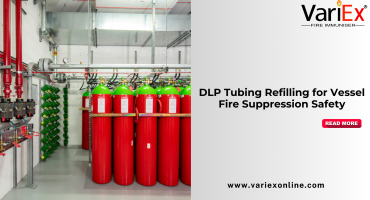![]()
Fire Immuniser
+91-7829629111
Email: info@variex.in
Varistor Technologies Pvt. Ltd.
Block-1, First Floor, Ardente Office One, Hoodi Circle, ITPL Main Road, Bengaluru, Karnataka 560048, IN
When Should You Refill Your Fire Extinguisher? Let’s Find Out!
Ever wondered if your fire extinguisher is up for the challenge when it really matters? It's one of those things we often forget about until it's too late. But here's the thing – knowing when to refill a fire extinguisher can make all the difference in an emergency. In this blog post, we're tackling a vital question: When Should You Refill Your Fire Extinguisher? No complex jargon, just plain talk about signs to look out for and why it matters. Whether you're a homeowner or just someone who wants to keep their surroundings safe, we're on a mission to make sure your first line of defense against fire is top-notch.
Understanding Extinguisher Operation:
These devices function on the principle of removing one or more elements vital for fire – heat, fuel, or oxygen – thereby interrupting the combustion process.
Cooling Effect: Water-based extinguishers capitalize on the cooling effect, extracting heat from the fire triangle and lowering the temperature below the ignition point.
Smothering Flames: Extinguishers employing foam, powder, or carbon dioxide work by creating a barrier between the fuel and oxygen, effectively smothering the flames and inhibiting combustion.
Chemical Reaction: Class K extinguishers employ a chemical reaction to transform burning fats and oils into soap-like substances, preventing the fire from re-igniting.
Multiplicity of Types:
Fire extinguishers are not a one-size-fits-all solution; they are meticulously crafted to tackle different fire classes. There are five primary classes of fires, namely Class A, B, C, D, and K. Each class corresponds to a specific type of fuel, necessitating tailored extinguishing agents.
- Class A Extinguishers: Primarily effective against fires fueled by common combustibles like wood, paper, and cloth, Class A extinguishers utilize water or water-based solutions to cool and extinguish the flames.
- Class B Extinguishers: Flammable liquids and gases pose a distinct threat, necessitating Class B extinguishers. These extinguishers deploy foam, powder, or carbon dioxide to smother the fire and interrupt the combustion process.
- Class C Extinguishers: When dealing with electrical fires, where live electrical equipment is involved, Class C extinguishers are indispensable. They contain non-conductive agents that suppress the fire without endangering the user.
- Class D Extinguishers: Fires fueled by combustible metals, such as magnesium or titanium, demand the specialized approach of Class D extinguishers. These extinguishers use dry powder to starve the fire of its oxygen supply.
- Class K Extinguishers: In commercial kitchens, where grease fires are a constant risk, Class K extinguishers, typically using wet chemical agents, are the frontline defense. They work by saponifying the burning fats and oils.
Signs of a Depleted Fire Extinguisher
Visual Clues:
First off, let's talk about what your eyes can tell you. Take a good look at your fire extinguisher – it's not just a red wall ornament! Check the pressure gauge; think of it as the heartbeat monitor for your firefighting sidekick. If the needle is in the green, all's well. But if it's flirting with the red zone or looks like it's napping, it's time for a refill.
Next up, give your extinguisher a once-over. Any cracks, dents, or leaks? These are like battle scars, but if there are too many, your extinguisher might be waving the white flag. Firefighting gear isn't invincible, and wear and tear happen, so don't brush off these visual cues.
Common Wear and Tear:
Now, let's talk about wear and tear – the silent enemy. Flip your extinguisher and check the bottom. See any powdery residue? That's not fairy dust; it's a sign that your fire-fighting buddy has been through the wringer. Sometimes, even the bravest warriors need a breather. Take a moment to appreciate the pull pin – it's the unsung hero of operation. If it's missing or looks like it has seen better days, it might not be up to the task when the curtain rises on the fiery stage. And let's not forget the hose – the lifeline of your extinguisher. If it's cracked or feels like a limp noodle, it's not going to deliver a stellar performance when the fire sparks.
Regular Inspections: A Crucial Ste
The Significance of Routine Checks:
Imagine relying on a safety net that, unbeknownst to you, has developed holes over time. Fire extinguishers are no different. Regular inspections serve as a preemptive strike against potential malfunctions, ensuring that when the need arises, these firefighting tools perform at their optimal capacity. A neglected fire extinguisher might be the difference between a contained incident and a full-blown catastrophe. By incorporating routine checks into your safety regimen, you essentially grant yourself the peace of mind that comes with knowing your first line of defense is armed and ready. It's not merely about compliance with safety regulations; it's about taking proactive measures to safeguard lives and property.
The DIY Inspection Guide:
Embarking on a DIY inspection journey need not be a daunting task. In fact, it positions you as a proactive guardian of your safety. Begin your inspection with a visual sweep – the eyes are your first line of defense. Check the pressure gauge; it's the heartbeat monitor of your extinguisher. If it's in the green, your extinguisher is in good health. A needle in the red zone, however, signals the need for immediate attention.
Next, give your extinguisher a thorough once-over. Look for cracks, dents, or any signs of leakage. These visual cues might seem minor, but they are indicative of the wear and tear your extinguisher has endured. Just like any warrior, it needs periodic assessments to ensure it's battle-ready. Flip your extinguisher and inspect the bottom. Any powdery residue is a red flag, indicating a past battle with flames. The pull pin, often overlooked, is a crucial component. Missing or damaged, it compromises the operability of the extinguisher. The hose, your extinguisher's lifeline, merits attention too. If it's cracked or feels compromised, it's time to consider a replacement.
Expiration Dates and Maintenance
The Shelf Life Conundrum:
Fire extinguishers, despite their robust appearance, are not immune to the passage of time. Every extinguisher comes with an expiration date, a date that signifies the point beyond which its reliability diminishes. This date is not arbitrary; it is a calculated timeframe during which the extinguisher is expected to function optimally. Ignoring or neglecting this date is akin to relying on a time-battered shield in the heat of battle. Understanding the shelf life of a fire extinguisher involves acknowledging that the chemicals and components within have a finite efficacy. Over time, factors like temperature fluctuations, exposure to the elements, and simple aging can compromise the extinguisher's ability to perform effectively. Therefore, checking the expiration date on your extinguisher is not just a formality; it is an essential step in ensuring your safety apparatus remains trustworthy.
Tips for Maintenance:
Maintenance, the unsung hero of fire safety, plays a pivotal role in extending the lifespan of fire extinguishers. Routine checks, beyond the periodic expiration date scrutiny, are essential to guaranteeing that your firefighting ally is always battle-ready. Start with a visual inspection. Examine the pressure gauge – it's the pulse of your extinguisher. A healthy extinguisher shows a needle comfortably in the green zone. If it's flirting with the red, it's time to consider a replacement.
The body of your extinguisher tells a story of its own. Cracks, dents, or signs of leakage are like battle scars; a few are acceptable, but an excess signals the need for attention. Consider it a health check for your extinguisher. Flip your extinguisher and inspect the bottom. Any powdery residue might indicate a past skirmish with flames. The pull pin, seemingly inconspicuous, is a vital component. If it's missing or damaged, the functionality of your extinguisher is compromised. The hose, often overlooked, is the lifeline of your extinguisher. Give it a once-over. Cracks or any compromise in its integrity should not be brushed aside.
Extending the Lifespan:
Extending the lifespan of your fire extinguisher is not rocket science; it's a commitment to regular maintenance. Store your extinguisher in a temperate environment away from direct sunlight or extreme temperatures. Ensure it's easily accessible and not buried under layers of clutter. Conduct routine visual inspections, not as a task, but as a habit. Make it a part of your safety routine, like checking the batteries in your smoke detectors. Regularity is the key to ensuring that your fire extinguisher remains a reliable ally in the unpredictable theater of fire safety.
Where to Refill Your Fire Extinguisher
Authorized Refill Centers:
When it comes to refilling fire extinguishers, seeking out authorized refill centers is akin to entrusting your weapon to the skilled hands of a master blacksmith. These centers are not just repositories of fire-extinguishing magic; they are certified hubs that adhere to safety standards, ensuring that the lifeblood of your firefighting tool is replenished with precision. Authorized refill centers are equipped with professionals trained in the nuances of fire extinguisher maintenance. They understand the chemistry within the canister, ensuring that the right extinguishing agent is replenished. It's not a mere refill; it's a recalibration of your safety net, ensuring that when the need arises, your extinguisher is armed and ready.
Online and Offline Options:
In the digital age, convenience is often a keystroke away. Online options for fire extinguisher refills have emerged, offering a streamlined solution for those with busy schedules or limited accessibility to physical refill centers. These online services often provide shipping options, allowing users to send in their extinguishers for a recharge without leaving the comfort of their homes or businesses.
However, for those who prefer a more tangible approach, offline options abound. Local hardware stores, safety equipment suppliers, and even fire departments often offer refill services. These brick-and-mortar establishments not only provide the convenience of an immediate refill but also the assurance of face-to-face interactions with professionals who can offer guidance on maintenance and usage.
Factors to Consider:
Choosing where to refill your fire extinguisher involves considering a few factors beyond mere convenience. Look for authorized centers that adhere to safety standards and regulations. Check for certifications and reviews, ensuring that the center has a track record of quality service. Consider the type of extinguisher you have. Different extinguishers require specific refilling agents, and not all refill centers may be equipped to handle every type. Ensure that the chosen center has the expertise to replenish the specific extinguisher in your possession.
In the journey through the intricacies of fire safety, the question of when to refill your fire extinguisher emerges as a pivotal chapter. We've explored the nuances of expiration dates, the significance of routine maintenance, and even ventured into the realm of authorized refill centers. Now, as we conclude this exploration into the world of fire preparedness, the answer to the question becomes a beacon guiding us towards a safer tomorrow. Knowing when to refill your fire extinguisher is not merely a matter of checking a box on a to-do list; it's an act of vigilance, a commitment to being the stalwart defender in the face of the unpredictable dance of flames. Your fire extinguisher, often relegated to the periphery until a crisis looms, demands attention, care, and timely replenishment to remain a reliable guardian. Consider the expiration date – that silent but crucial timestamp on your extinguisher. It's not just a number; it's a reminder that the efficacy of the extinguishing agents within has a finite lifespan. Ignoring this date is akin to relying on a faded map in uncharted territory – a risky proposition that may lead to dire consequences.
Routine maintenance, as we've discussed, is the unsung hero in extending the lifespan of your firefighting tool. It's the health check that ensures your extinguisher is ready to spring into action when the need arises. Cracks, dents, leakage – these are not mere blemishes but signals that your extinguisher has weathered storms and might need a little tender care. Refilling your fire extinguisher is not just a task; it's a conscious effort to bridge the gap between potential disaster and preparedness. It's acknowledging that fire safety is not a one-time affair but an ongoing commitment to safeguarding lives and property. Whether opting for an online service or heading to an authorized refill center, the choice is a testament to your dedication to being a responsible guardian of your safety.
In conclusion, the when of fire extinguisher refilling is not a fixed date on the calendar; it's a dynamic interplay of expiration dates, routine maintenance, and a keen awareness of your extinguisher's health. It's a commitment to staying ahead of the curve, to being the unsung hero in the story of fire safety. As we navigate the unpredictable terrain of potential fire hazards, let the answer to when be a resounding call to action – a call that echoes the sentiment that safety is not a passive endeavor but an ongoing, vigilant partnership with the tools that stand between us and the flames. So, when should you refill your fire extinguisher? The answer is clear – now, and always.
Frequently Asked Questions
1. When should I check the expiration date of my fire extinguisher?
It is advisable to check the expiration date of your fire extinguisher at least once a year. This routine inspection ensures that you are aware of when the extinguisher may need a refill, as the expiration date signifies the period beyond which its effectiveness may decline.
2. How often should I visually inspect my fire extinguisher for signs of wear and tear?
Conduct a visual inspection of your fire extinguisher monthly. Look for cracks, dents, or any visible signs of leakage. This regular check helps identify early signs of wear and tear, allowing for timely maintenance and potentially extending the lifespan of your extinguisher.
3. Can I refill my fire extinguisher myself, or should I seek professional services?
While some small maintenance tasks can be performed by users, such as checking the pressure gauge and ensuring the extinguisher is free from obstructions, refilling should be done by professionals. Authorized refill centers have the expertise and equipment to ensure the extinguishing agent is replenished correctly.
4. What are the consequences of using an expired or damaged fire extinguisher?
Using an expired or damaged fire extinguisher can lead to ineffective fire suppression, putting lives and property at risk. The extinguishing agents may have degraded, reducing their ability to combat flames. It is crucial to replace or refill an extinguisher that has reached its expiration date or shows signs of damage.
5. How can I find an authorized refill center for my fire extinguisher?
Look for local hardware stores, safety equipment suppliers, or fire departments that offer authorized refill services. Online options are also available, where you can send your extinguisher to a certified refill center for replenishment. Ensure that the chosen center adheres to safety standards and regulations.
Final Say
We at VariEx.in or Variexonline.com have mastered the art of designing, installing, inspecting, and fixing automatic sprinkler systems with the help of our in-house team, which is capable of delivering the fire sprinkler services you need, whether large or small and at affordable cost.
To schedule a fire sprinkler installation, or you think our services could benefit your commercial property, contact us online or give us a call at, 7829629111
"WHAT YOU CAN READ NEXT"
 Read more +24 November 2023 in Fire Extinguisher
Read more +24 November 2023 in Fire ExtinguisherWhat types of fire extinguishers are available for different fire classes?
 Read more +11 July 2025 in Fire Suppression
Read more +11 July 2025 in Fire Suppression






